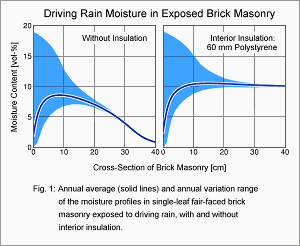 From a hygrothermal point of view, an exterior insulation is in general preferable over an interior insulation. However, economical aspects or the wish to preserve historical facades may rule out exterior insulation, so that interior insulation remains the only way to reduce the energy consumption of a building and to increase comfort. The resulting risk of interstitial condensation and possible countermeasures (e.g. vapor barriers) are widely known.
From a hygrothermal point of view, an exterior insulation is in general preferable over an interior insulation. However, economical aspects or the wish to preserve historical facades may rule out exterior insulation, so that interior insulation remains the only way to reduce the energy consumption of a building and to increase comfort. The resulting risk of interstitial condensation and possible countermeasures (e.g. vapor barriers) are widely known.
It is less well known, however, that an interior insulation affects the moisture content of a facade exposed to rain and may increase the risk of frost damage. The influence of this effect on the moisture behaviour of a fair-faced solid-brick masonry wall exposed to driving rain has been investigated by computational simulation in [1] and has been verified by accompanying open-air experiments. Fig. 1 shows the moisture conditions in a 40-cm-thick masonry wall without and with interior insulation after periodic equilibrium has been reached (that is, the simulation is run for several years, always applying the same yearly weather data, until the transient moisture profiles repeat from one year to the next). The blue area shows the bandwidth of the moisture contents occuring during one year, plotted over the cross-section of the walls. The dark curve describes the yearly averages of the moisture contents for the region between the exterior surface of the wall and the point close to the interior surface where the interior rendering or the polystyrene foam insulation begins.
Despite recurring water saturation of the facade during periods of intense driving rain, the average moisture content at the exterior surface corresponds roughly to the reference moisture content of the masonry because sunshine quickly dries the surface. Due to the strong moisture-dependence of capillary transport, however, deeper below the surface the average moisture content increases quickly. In the wall without interior insulation, the moisture content reaches a maximum at a depth of a few centimeters and then decreases quite smoothly until it reaches the hygroscopic dry level on the indoor side. Beyond a depth of about 20 cm, the moisture content shows no variation over the whole year, that is, the transient outdoor climate only affects the exterior half of the masonry.
Applying an interior insulation changes the moisture conditions in the masonry drastically. Below the exterior surface, the moisture content now increases even stronger, without ever decreasing towards the indoor side. There are two reasons for this: while the driving rain load has not changed, the diffusion resistance of the polystyrene insulation slab impedes the drying through the indoor surface, and in addition the average temperature level of the masonry is reduced by the insulation, so that drying towards the exterior side is slowed down, too. In comparison with the uninsulated case the total moisture content in the insulated wall is noticeably increased. The risk of frost damage is increased accordingly and can only be reduced by improved rain protection such as hydrophobic facade treatments [1].
Literature
Künzel, H.M. und Kießl, K.: Feuchte- und Wärmeschutz von Sichtmauerwerk mit und ohne Fassadenhydrophobierung. Mauerwerksbau aktuell 98 (1998) S. D48-D57.
Page created: 09 May 2007; last update: 17 Jul 2012